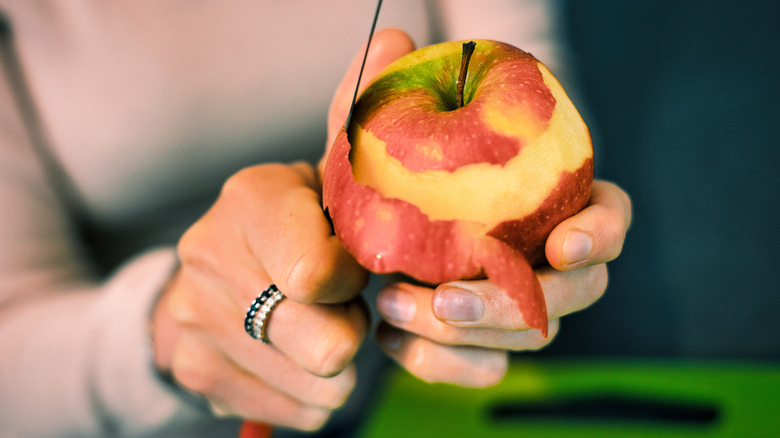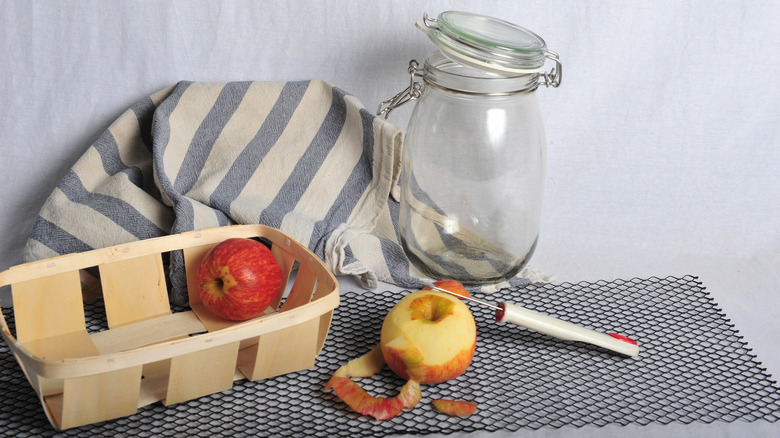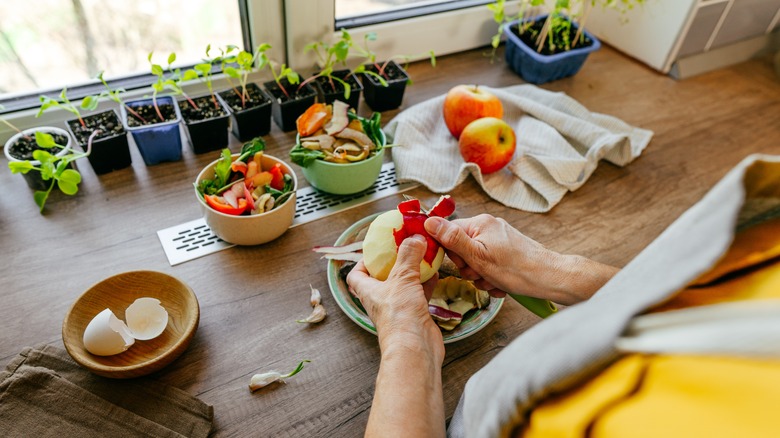Don't Throw Out Your Apple Peels, Here's How To Use Them In Your Garden
Your garden needs three essential nutrients to thrive; nitrogen, phosphorus, and potassium. While commercial fertilizers are available to feed your plants, you can make your own for no additional cost by saving kitchen scraps like apple peels. A medium-sized apple is filled with 193 milligrams of potassium to produce strong plants. By using the peels in your garden, you can encourage flower growth and boost fruit production.
Apple peels are so beneficial to plants because they also contain necessary micronutrients. One will have around 10 milligrams of calcium. Without it, the foliage would become thin instead of luscious. Using apple peels as fertilizer for your garden is a great way to save them from landfills. Even though they are biodegradable, it's better to find a use for them in your home instead of throwing them away. When they end up in landfills, they're buried in order to break down. That causes them to release methane, a dangerous greenhouse gas that worsens climate change. Luckily, you can choose the eco-friendly and money-saving option of turning your leftover apple peels into fertilizer for your garden.
Make an apple peel tea
Turning your apple peels into fertilizer tea is one of the best ways to nourish your garden. Since you brew it for multiple days, the fruit breaks down and releases potassium and calcium into the water. Then when you pour it over your plants, they get to immediately absorb the nutrients and use them to grow. First, you'll need to snack on some apples and save the peels.
Take your peels and cut them into small pieces. Then place them into a container with a lid, like a mason jar. Although, you don't want to close it completely because the mixture will ferment as the apple breaks down. If you have peels from two fruits, fill the container with 500 milliliters of water. For a smaller batch, you can mix one large apple's worth of peels with 250 milliliters of water.
Then cover the jar and place it in a shady spot. After three to five days, the peels will have transferred all their nutrition into the water. Strain the apple out of the solution and throw them into your compost to continue reusing them. You're left with a liquid fertilizer that's very potent, so you'll need to dilute it with water. Follow a one-to-one ratio and pour it directly into the soil around your plants.
Bury apple peels in the soil
There are multiple ways to use apple peels as a natural fertilizer for your garden. If you don't have the extra time to brew them into tea, you can try a more straightforward method where you add them directly to the soil. It's less work for you, but may take longer for your plants to actually benefit from the peels. This is because they will need to begin decomposing for the nutrients to release. Meanwhile, with the tea, you're jumpstarting that process.
The trick to making this method work best is chopping the apple peels into very tiny pieces. The smaller they are, the better because they will break down easier. Then take the peels and spread them on top of the soil around the base of your plants. If you want to take it a step further, you can bury them in the dirt to prevent any bad smells or attracting any pests. As the peels decompose over the next few weeks to months, they will add much needed nutrients into the soil for your plants to absorb.


